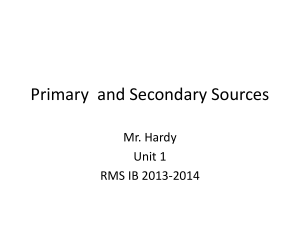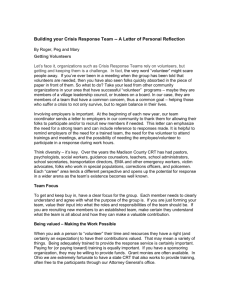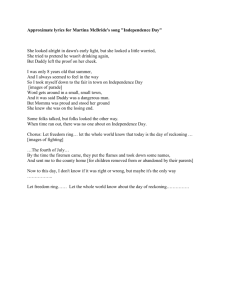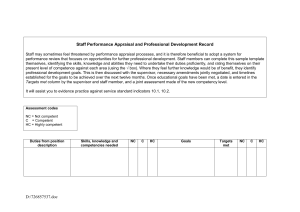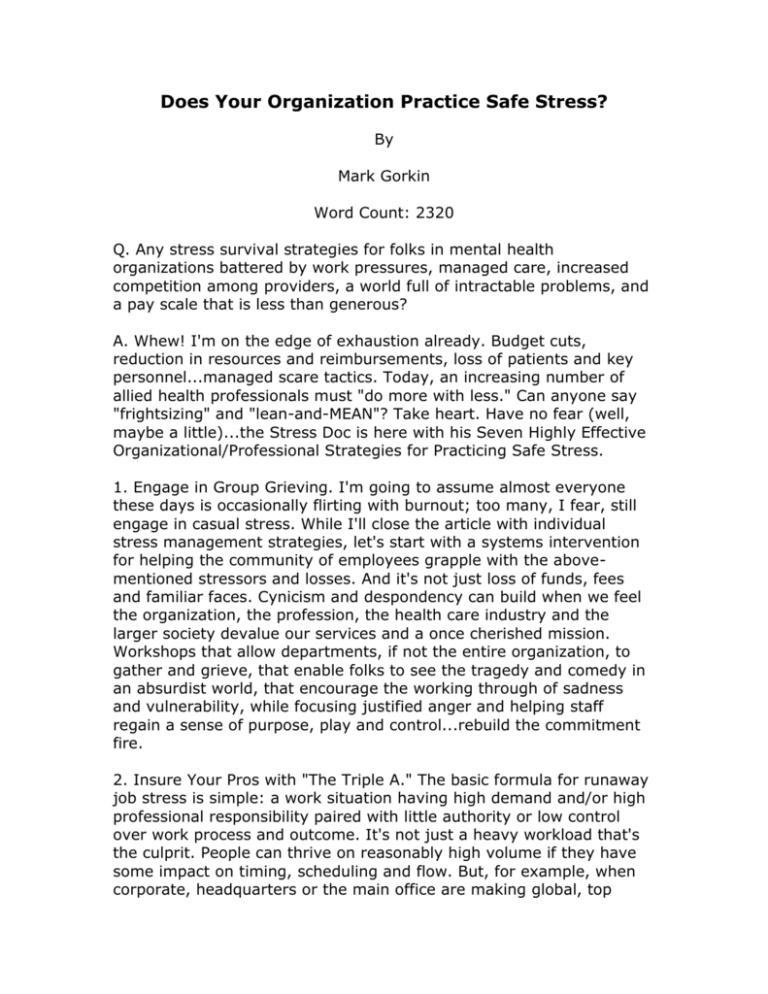
Does Your Organization Practice Safe Stress?
By
Mark Gorkin
Word Count: 2320
Q. Any stress survival strategies for folks in mental health
organizations battered by work pressures, managed care, increased
competition among providers, a world full of intractable problems, and
a pay scale that is less than generous?
A. Whew! I'm on the edge of exhaustion already. Budget cuts,
reduction in resources and reimbursements, loss of patients and key
personnel...managed scare tactics. Today, an increasing number of
allied health professionals must "do more with less." Can anyone say
"frightsizing" and "lean-and-MEAN"? Take heart. Have no fear (well,
maybe a little)...the Stress Doc is here with his Seven Highly Effective
Organizational/Professional Strategies for Practicing Safe Stress.
1. Engage in Group Grieving. I'm going to assume almost everyone
these days is occasionally flirting with burnout; too many, I fear, still
engage in casual stress. While I'll close the article with individual
stress management strategies, let's start with a systems intervention
for helping the community of employees grapple with the abovementioned stressors and losses. And it's not just loss of funds, fees
and familiar faces. Cynicism and despondency can build when we feel
the organization, the profession, the health care industry and the
larger society devalue our services and a once cherished mission.
Workshops that allow departments, if not the entire organization, to
gather and grieve, that enable folks to see the tragedy and comedy in
an absurdist world, that encourage the working through of sadness
and vulnerability, while focusing justified anger and helping staff
regain a sense of purpose, play and control...rebuild the commitment
fire.
2. Insure Your Pros with "The Triple A." The basic formula for runaway
job stress is simple: a work situation having high demand and/or high
professional responsibility paired with little authority or low control
over work process and outcome. It's not just a heavy workload that's
the culprit. People can thrive on reasonably high volume if they have
some impact on timing, scheduling and flow. But, for example, when
corporate, headquarters or the main office are making global, top
down decisions that are fairly out of touch with local needs and
operational realities the consequences are often demoralizing.
In these volatile times, here are two philosophical and policy pillars for
supporting employee integrity:
a) Encourage and Integrate The Triple 'A' of
Professional/Organizational Responsibility: Authority, Autonomy
and Accountability. Remember, management must let
professionals exercise reasonable independence and individuality
in thought and practice. Professionals must understand that
accountability to clients and professional management, i.e.,
effective and ethical management, supports autonomy and
credibility. Also, the accountability process legitimizes the need
for and strengthens the quality of service delivery.
b) Question the notion of customer as king. During my years as a
stress consultant to the US Postal Service, customer service was
top priority. However, the USPS realized that resentment and
depletion build when an operation is customer-driven and
employee negligent. To challenge an organizational ambience
where "client is king" and staff are withered and weary peasants,
consider my Basic Law of Safe Stress: "Do know your limits and
don't limit your 'no's!" Clearly, I'm not saying slam the door shut
on your client population. I do mean practicing "N & N" -- the
ability to say "no" and to "negotiate," for example, the number
of clients in a caseload or people seen in a day.
Closed door time is also vital for paper work, individual reflection and
colleaguial bantering and nurturing. And speaking of nurturing, some
private time and space allows for my favorite - brief, restorative power
napping; highly preferable to caffeine overloading.
3. Make Task and Process Meet. "Not another meeting." "Who has time
for meetings?!" These can become familiar, plaintive cries in a
downsized, pressure-packed setting. Drastically reducing
organizational, departmental or team meetings is only a formula for
isolation and confusion; making community time meaningful is the
key.
Many organizations under a time and resource crunch become
increasingly task-driven. After the proverbial status report, meetings
are run somewhat like the opening to "Mission Impossible":
hierarchical assignments are detailed and delegated, though folks
usually aren't asked if they choose to accept. Kidding aside, often
lacking is some balance between a task focus and a relationship-group
process one. At some point, the meeting needs to connect with how
well people are working together, how coordinated the communication,
how is stress and conflict being managed, within the team and among
various departments...Is the atmosphere one of "esprit de corps" or
esprit de corpse?
Three suggestions:
a) Establish a Wavelength Segment. In an hour or ninety minute
meeting, set aside fifteen or twenty minutes for processing, usually
at the end of the session. Individuals and the team as a whole can
check in and tune in with each other.
b) Rotate Leadership. A common mistake is always having a
supervisor or manager run the show. Rotating the facilitator can
enhance group involvement and commitment, reduce hierarchical
decision-making and strengthen team concept and team morale.
Also, this procedural shift gives supervisors an opportunity to be a
real member of the group, providing an observational vantage
point for better grasping group dynamics. The biggest challenge,
as always, involves control and competition issues: whether the
supervisor and the staff can be comfortable with his or her (i.e.,
the supervisor) wearing two hats - being both formal authority in a
primary role and peer in the team meeting.
c) Try a Morning Quickie. Sometimes an alternative to a formal
meeting can be a ten minute huddle at the beginning of the day.
How about warming up the team by sharing a joke or funny story,
with a prize for the best joke of the month. A quick gathering
makes it easy for giving the troops a heads up and for affirming
that all are on the same day game page.
4. Envision Mission and Goals. With the above policies, structures and
procedures in place, hopefully, your organization is no longer a
candidate for becoming the land-based version of the Titanic. Agency
and staff will not be sinking and disappearing. Perhaps management
by crisis can be replaced by proactive leadership and creative
consensus. This is especially critical after a major restructuring or
downsizing. Set aside some team building/staff training time. If you
haven't already done so, consider bringing in a "Team Visioning and
Goal Setting" consultant. For a mission statement to be viable and for
action plans that realize goals and objectives there needs to both short
term and long range planning and buy in from staff.
Of course, the danger of a big picture retreat is that people and
perspective can get swept away by ideals and rhetoric. Remember,
there's often a fine line between vision and hallucination. To preserve
that boundary, integrate past, present and future with my "Four 'F'
Model of Loss and Change":
1) examine honestly and openly the strengths and vulnerabilities of
the familiar past,
2) collectively grieve any loss of face or organizational identity and
pride,
3) recommit to a collaborative method of conflict resolution to
nurture a diverse, participatory team focus, and
4) explore new problem-solving options and opportunities for a
pregnant and expansive future. (Hey, what kind of imagery do
you expect in an article on "Safe Stress?")
5. Manage Stress Carriers. Now for a delicate matter. Some folks,
even after partaking in these potentially rejuvenating steps, will not be
able to rebuild the fire; there's no renewing a genuine sense of
individual and/or organizational purpose and commitment. At least not
on their own. A percentage may respond to individual supervision and
coaching. Others may benefit from Employee Assistance Program
(EAP) counseling or, hopefully, will seek out private psychotherapy.
However, there may be a few individuals just not able to function in
the still demanding day-to-day environment. I can't emphasize this
enough: when management does not set appropriate limits and
boundaries on such professional "stress carriers," team morale and
productivity are contaminated and compromised.
Sometimes employees have to intervene with a supervisor or
management before decision-makers realize they are ignoring or
covering up for an impaired colleague (who also may be a personal
friend or, even, a high producer). Clearly, fair, effective ("do the right
thing') and efficient ("do the thing right") grievance procedures must
be in place. Engaging this troubled individual is essential for his or her
sake as well as for others. Remember, stress carriers (including
managers in denial) may not get ulcers but they certainly can give
them!
6. Fireproof Life with IRAs and PUNCH. Despite, or because of, the
future shock pace of change, some professionals will have "been there,
done that" one too many times. (Organizational crisis often surfaces
chronic individual frustrations.) Maybe it's the 300th couple counseling
session or "not another sexual abuser." These folks may be
experiencing what I call 'The Bjorn Bored Syndrome (BBS)," named for
the late '70s-early '80s tennis great, Bjorn Borg. Borg, after a five year
reign, dramatically burned out on the circuit. BBS has a simply elegant
formula: when mastery times monotony provides an index of MISERY!
The answer: Fireproof your life with variety. And for management and
staff,I offer two stimulating acronyms:
a) Organizational IRAs. Provide "Incentives, Rewards and
Advancement Opportunities" for employees. Merit bonuses, new
training, conference attendance keep the mind, heart and soul
supple and dynamic. I experienced LMR - Lateral Movement
Revival - from doing EAP Orientation training and short-term
counseling when the New Orleans Family Services Society
started an EAP venture with a federal government agency. The
move also laid the groundwork for a future training/consulting
career path.
b) Entrepreneurial PUNCH. More than ever, organizations must
develop new clients and resources. Professionals need to
springboard from the office into the larger community to market
mental health services. The entrepreneurial spirit is calling. I've
detailed how to embrace it. Here's a quick outline of skills and
strategies for entrepreneurial evolution and rejuvenation,
whether a professional chooses to stay with the organization or
to move on:
P. Public Presentation. Public speaking and workshop leading is
both a powerful marketing vehicle and a most challenging,
exhilarating and growth producing opportunity. So too meeting a
wide variety of consumers and colleagues.
U. User-Friendly. Avoiding psychobabble and communicating
ideas and concepts with an expanded audience - face-to-face or
through writing and the electronic media - in a lively and tangible,
meaningful and memorable style is critical. For example, are you
ready to help folks "Practice Safe Stress" or confront "The Intimate
FOE: Fear of Exposure?"
N. Networking. Make connections with a variety of consumer
groups and professional associations, not only with therapists and
clinical societies. Recently, in addition to social workers, two
dentists and a marketer attended my public speaking/program
marketing seminar. Two years ago, hobnobbing with self-employed
business folks opened the door to the wonders of space travel.
C. Cyberspace and (Mass) Communications. There's a whole
new internet frontier rapidly being explored and developed with
myriad possibilities for clinicians and organizations - from EAP
assistance and specialty chat groups to distance learning and
training. Go web young cyber-ite!
H. Humor. You don't have to be a standup comic, just appreciate
the absurdity in the world and laugh at and share your own
imperfect humanness. Remember, people are more willing, even
eager, to open and receive a serious message when it's giftwrapped with humor. Every mental health organization needs at
least one in-house "psychohumorist"™.
7. Develop Psychological Hardiness. While this article has especially
focused on team strategies, a vital group and community requires
healthy and hardy individuals. Here are some final stress management
strategies based on a study with AT&T executives. During the break up
of Ma Bell in the '80s, researchers discovered four factors that
distinguished execs susceptible to physical and emotional illness from
those who demonstrated "psychological hardiness." To survive and
thrive in a turbulent transition, build in these "Four 'C's of Masterful
Coping":
a. Commitment. While invested in the company's
reorganization, the hardy execs didn't just have a work
life. They had a life...and were nurtured by family, friends,
religious practice, recreation and hobbies.
b. Control. Hardy execs had a realistic and less rigid sense of
control; they avoided self-defeating turf battles. A swollen
ego did not hinder their stepping back and reassessing the
changing landscape.
c. Change. Quickly dealing with feelings of loss, while not
harboring false hopes and illusions about the future
enabled these individuals to explore new options. Hardy
players viewed change as a stepping stone not a stumbling
block.
d. Conditioning. Finally, the most hardy execs engaged in
regular physical exercise. Thirty minutes of aerobic
exercise - walking, jogging, swimming, bike riding, etc. releases the body's natural pain killers and mood
enhancers. Equally important, in times of stressful
transition, exercise grounds us when everything else
seems up in the air; there's a beginning and end point,
providing a tangible sense of accomplishment and control.
In closing, in these tumultuous times organizations must help rebuild
individual energy. Management and professionals must together
cultivate conflict managing and harmonizing team structures along
with healthy boundaries both within and with the outer environment.
Organizations also need to encourage career and skill evolution and
responsibility for professional productivity and personal integrity. It
takes a systems approach and individual hard work to forge that
elusive balance: giving to your organization, colleagues and clients as
well as getting from others and giving to yourself. But when you create
that balance, you definitely are...Practicing Safe Stress!
Mark Gorkin, LICSW, "The Stress Doc" ™, is an internationally
recognized speaker and syndicated writer on stress, anger
management, reorganizational change, team building and HUMOR! The
Doc is also America Online's "Online Psychohumorist" ™ and leads a
weekly "Shrink Rap ™ and Group Chat" for AOL/Digital
City. Copyright© 2003, Mark Gorkin. All rights reserved. For
information about The Stress Doc's presentations, contact the Frog
Pond at 800.704.FROG(3764) or email susie@frogpond.com;
http://www.frogpond.com



